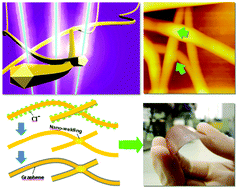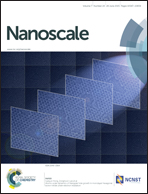Direct synthesis of graphene 3D-coated Cu nanosilks network for antioxidant transparent conducting electrode†
Abstract
Transparent conducting film occupies an important position in various optoelectronic devices. To replace the costly tin-doped indium oxide (ITO), promising materials, such as metal nanowires and graphene, have been widely studied. Moreover, a long-pursued goal is to consolidate these two materials together and express their outstanding properties simultaneously. We successfully achieved a direct 3D coating of a graphene layer on an interlacing Cu nanosilks network by the low pressure chemical vapor deposition method. High aspect ratio Cu nanosilks (13 nm diameter with 40 μm length) were synthesized through the nickel ion catalytic process. Large-size, transparent conducting film was successfully fabricated with Cu nanosilks ink by the imprint method. A magnetic manipulator equipped with a copper capsule was used to produce high Cu vapor pressure on Cu nanosilks and realize the graphene 3D-coating. The coated Cu@graphene nanosilks network achieved high transparency, low sheet resistance (41 Ohm sq−1 at 95% transmittance) and robust antioxidant ability. With this technique, the transfer process of graphene is no longer needed, and a flexible, uniform and high-performance transparent conducting film could be fabricated in unlimited size.


 Please wait while we load your content...
Please wait while we load your content...